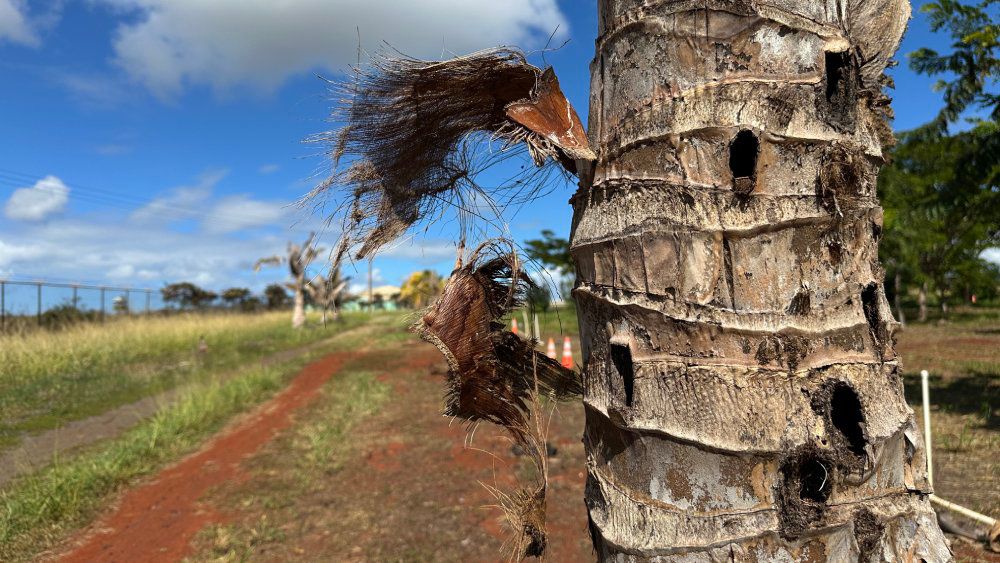City’s Department of Planning and Permitting addresses CRB threat
May 8, 2025
The city’s Department of Planning and Permitting may not be experts in landscaping, but they work closely with the Honolulu Department of Parks and Recreation’s Division of Urban Forestry to promote the health and preservation of urban forestry. In so doing, the department is addressing growing concerns over the Coconut Rhinoceros Beetle.
The DPP implemented a policy on March 15, 2024, aimed at slowing the spread of the invasive species threatening the health of Hawaii’s iconic palm trees and by extension, community forests, until effective treatments become available.
The policy is focused on areas that fall under DPP’s authority that includes the following measures:
- Prohibiting palms from fulfilling street tree requirements.
- Discouraging the use of palms to meet landscaping requirements.
- Limiting the use of compost, wood, tree chips and mulch that may harbor CRB.
- Requiring compliance with the Hawaii Department of Agriculture’s interim rule that restricts the movement of materials that could be carrying CRB.
- Mandating an invasive species management plan for affected developments.
- Ensuring damaged palms are replaced with tree species that are not susceptible to CRB.
However, despite the policy, DPP continues to see new urban landscapes dominated by palms. Officials point to recent plantings in Kakaako and Ala Moana that have already shown signs of CRB damage, which raises concerns about introducing CRB breeding populations to the “palm-rich corridor” that extends from ʻIolani Palace to Lēʻahi (Diamond Head). If a CRB breeding population were to establish itself anywhere along this stretch, many palm trees that contribute to the area’s aesthetic and cultural identity could be lost.

The Department of Planning and Permitting discourages the use of palms to meet landscaping requirements or to replace damaged palms. (Photo courtesy of City and County of Honolulu)
Palms such as coconut and loulu reflect Hawaii’s heritage and landscape and symbolize the islands’ beauty and cultural significance. Though popular for landscaping choices, the spread of CRB to these iconic trees could lead to their destruction and threaten the cultural and visual identity palms provide to urban environments.
DPP officials encourage residents and developers to consider alternative tree species that are both beautiful and better suited to the individual environment. The Street Tree List suggests native and Polynesian-introduced species such as Alaheʻe, Ōʻhia, Hau, Milo, Kou, Kukui, Lonomea, Manele, Variegated Hau, and Kamani.

(Photo courtesy of City and County of Honolulu)
DPP encourages residents to consult with staff at local nurseries to select the right species for their location or take advantage of online resources:
- Right Tree Hawai‘i
- Trees for Honolulu’s Future
- Hawaiʻi Division of Forestry and Wildlife
- University of Hawaiʻi Native Plant Guide
- Department of Parks and Recreation, Urban Forestry TREEsources
There is currently no treatment that will completely eradicate CRB, but there are best practices to reduce their impact such as limiting the planting and movement of palms and implementing regular inspection and treatment protocols.
The CRB Hawaii Response website provides a helpful guide on treatments and best management practices for CRB prevention. The public can also contact DPP’s Urban Design Branch with questions about DPP policies, tree selection or CRB mitigation.
In addition, if you wish to have a tree planted in front of your residence, contact the Division of Urban Forestry at 808-971-7151 or emailing duf@honolulu.gov.

Compost, wood, tree chips and mulch are prime environments for CRB. (Photo courtesy of City and County of Honolulu)
Search
RECENT PRESS RELEASES
Related Post


